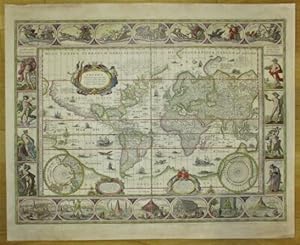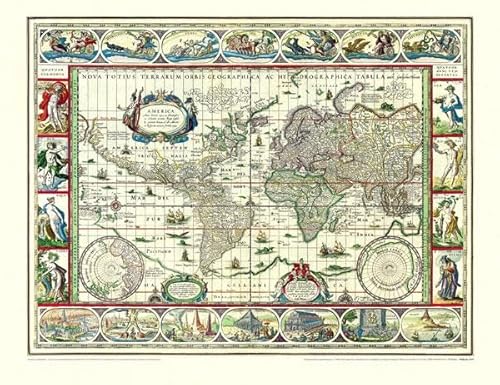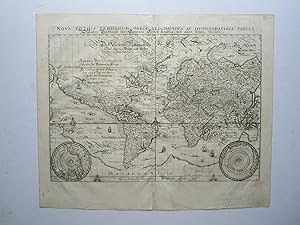Nova Totius Terrarum Orbis Geographica Ac Hydrographica Tabula Print by Donald Art Co
Skip to primary search results
-

Seller Image
No Binding. Condition: Very Skillful. Copper engraved map from Merian s Theatrum Eurpaeum, dedication to Christopher Columbus, two roundels showing north and south polar regions, ocean decorated with ships and body of water monsters, key vertical fold, overall size 385 x 325mm, Frankfurt, 1638 A stiff impression of Merian s edition of Blaeu southward famous map of the world, also using the Mercator projection and adding German language gothic script under the title and within the map. The oceans are decorated with numerous ships and ocean monsters and there is a big notation nearly Columbus and the discovery of the New World in identify of modern day Canada. To the south a large mythical landmass, Magallanica, spreads across the south encompassing Antarctica and Australasia. New Guinea is attached to Magallanica only partially mapped. Tierra del Fuego is separated from the landmass but pre-dates the discovery New Zealand. Due north America is separated from Asia by a narrow Strait of Anian. The Due east Declension is still very primitive, whereas on the Due west Declension California is shown as a peninsula. Korea however is shown as an isle, next to vague Nihon and an oversized Philippines. In Europe, the prospect of an open Northeast Passage to the Pacific is still prominently shown, with the coastlines of Nova Zembla, etc., notwithstanding only partially charted. Matth�us Merian, the famous Swiss publisher and engraver, began his career in Z�rich where he learned the fine art of copperplate engraving. Merian went on to study and work in various cities throughout French republic. In 1616 Merian moved to Frankfurt to work for the publisher Johann Theodor de Bry. Merian later on married de Bry's girl. He was also the father of Maria Sibylla Merian, i of the greatest natural history artists of the late 17th and early 18th centuries.
-

Seller Image
Incisione originale su rame (cm. 36x27,5 pi� margini) tratta dall'opera 'Archontologia cosmica, sive Imperiorum, regnorum, principatuum, rerumque publicarum omnium per totum terrarum orbem commentarii.' di Pierre d'Avity. Carta vergellata con filigrana. Raffinata coloritura all'acquarello. Margini laterali bianchi aggiunti, ma ottimo esemplare.
-

Ane of the supreme examples of the map maker's art Double-folio engraved map of the earth, on a Mercator projection, with contemporary hand-colour in outline and in part. Blaeu'southward world map was first published separately in 1606 as a reduced version of his large world map of 1605. Its clarity, item, and striking classical ornamentation makes it "i of the supreme examples of the map maker's art" (Shirley). The map is shown on Mercator'south projection with a massive southern continent attached to New Guinea, with the toponyms "Embankment" and "Psittacorum region" taken from Marco Polo'southward travel memoirs. North America has the w bulge characteristic of the time, with the "Strait of Anian" noted. Korea is shown every bit an isle and Japan is in a kite-like shape. The edge of vignettes provide information on terrestrial and celestial cycles. The vertical borders incorporate allegorical representations of the four elements and the 4 seasons - they are linked past the zodiac symbols in each of the vig nettes showing the seasons. The zodiac signs are arranged in their seasonal triplicities, which represent one chemical element giving way to some other: for example, the spring triplicity of Aries, Taurus and Gemini represents h2o becoming burn. The upper border, as is plumbing fixtures for its content, shows the "septem planeta", including the lord's day and moon, as classical deities with their planetary symbols riding in chariots, suggesting their orbit. At the bottom are the seven wonders of the globe: the Hanging Gardens of Babylon, the Colossus straddling the harbour at Rhodes, the Pyramids, the Mausoleum of Halicarnassus at Cairo, the Temple of Diana, the Statue of Jupiter and the lighthouse at Alexandria. Two small projections of the poles appear in each corner, at that place are 3 decorative cartouches, ane concerning the discovery of North America. The nowadays example is the quaternary country: "Terra del Fuego" is shown every bit an isle; "Fretum le Maire" added to the lesser of South America; and the title changed to conclude "auct: Guiljelmo Blaeuw". Shirley 255.
-

Seller Prototype
Amsterdam, 1652. Original colour. 445 x 560mm. Restoration to margin and centre fold. This magnificent planisphere manages to include 30 split illustrations in its panels. Forth the top and lesser are equestrian portraits of the Twelve C�sars of Tacitus. The iv corners feature female allegorical figures of the Continents, with Europe as a shepherdess, Asia seated on a camel, Africa on a crocodile and America on an armadillo! The left border has prospects of Rome, Amsterdam, Jerusalem and Tunis, interspersed with illustrations of European, Asian and African dress. The right border is given over completely to America: the prospects of United mexican states Urban center, Havana, Pernambuco and Todos bone Santos Bay are separated by vignettes of North American natives, S Americans and the giants of the Magellan Strait. Originally published in 1639, virtually of the cartography has been copied from Blaeu, although Arctic America has been extended, as has the St Lawrence River. This country has the appointment 1652, the year of Visscher's death, added. SHIRLEY: 350.
-

Seller Image
Gro�e altkolorierte Kupferstich-Karte von ca. 1640. -- Mit lateinischem Text auf der R�ckseite. -- Blatt-Ma�due east: ca. 49,5 x 59 cm. -- im unteren �u�eren Mittelbug leicht hinterlegt, sonst sehr gut erhalten. || Large erstwhile colored map from c. 1640. With Latin text on verso. -- Exceptional and famous map by the Blaeu family that follows Yard. Mercator's projection. Richly decorated carte-a-figures with a edge that includes allegorical illustrations of the moon, the sun, the planets (illustrated in the form of gods of Greek mythology), the four elements on the left (fire, water, air, world), the four seasons on the right. The bottom border features images of the 7 wonders of the ancient world: the Hanging Gardens of Babylon, the Colossus straddling the harbor at Rhodes, the Pyramids, the Mausoleum of Halicarnassus at Cairo, the Temple of Diana, the Statue of Jupiter and the lighthouse at Alexandria. The map itself is decorated with three cartouches, ocean battles and ships, monsters and compass roses. The geographical source was Petrus Plancius's 1592 world map. -- slightly deposited on the lower outer centerfold, otherwise in very proficient status. || Dies ist ein Original! - Kein Nachdruck! - Keine Kopie! -- This is an original! - No copy! - No reprint! la.
-

Seller Paradigm
Ca. 41 cm ten 55,5 cm. Koeman Bl 5, one. Shirley 255. - Der vierte Zustand (Guiljelmo Blaeuw und ohne Datierung) dieser wohl sh�nsten Weltkarte des 17. Jahrhunderts. "It is celebrated equally 1 of the supreme examples of the map maker`due south art" (Shirley, Due south. 270). - Die Weltkarte, nach Mercators Projektion, ist umgeben von four Bildleisten und 2 kleinen Polkarten am unteren Rand. An den Seiten Allegorien der 4 Jahreszeiten und Elemente, am oberen Rand mittig Allegorie auf dice Sonne flankiert von Allegorien des Mondes und von five Planeten, am unteren Rand Darstellung der sieben Weltwunder. Interessant auch der kurze Text zur Entdeckung von Amerika in der Kartusche. - Verso deutscher Text. - Leicht gebr�unt und fleckig. Restaurierte L�suren in den R�ndern und im Falz. Die beiden oberen Ecken mit erg�nzten Einrissen (aber ohen Bildber�hrung). Im Bereich von "Brasilien" 2 kleine (ca. 2 cm x 0,iii cm und 1,5 cm x 0,2 cm) hinterlegte Einrisse (minimalster Buchstabenverlust und einige Millimeter erg�nzter Flu�lauf). *** *** Copyright: Matthaeus TRUPPE Buchhandlung & Antiquariat - Stubenberggasse seven - A-8010 Graz - ++43 (0)316 - 829552 *** *** Sprache: Deutsch Gewicht in Gramm: 0 Willem J. und Joan Blaeu, Novus Atlas, Das ist Weltbeschreibung.
-

Stock Image
Map. Status: Brand New. German language language. 25.00x2.05x1.97 inches. In Stock.
-

Stock Image
Map. Condition: Brand New. German language. 25.00x2.05x1.97 inches. In Stock.
-

Seller Image
No Binding. Condition: Very Good. copper engraved map; overall 33 x 39,5 cm, plate 26 x 35,5 cm. fold as issued; some waterstains; add. printer s creases; split lower c fold non affecting image; c fold slightly warped; o/w vg cond. This very detailed map of the Earth is from Merian s Neuwe Archontologia Cosmica, published from 1646 onwards and based on his earlier map, first issued in 1638. According to Shirley, there are subtle differences the virtually important i existence the absence of Merian south signature. Shirley (World) # 369.
-
![Seller image for A set of the world and four continents]. Nova Totius Terrarum Orbis Geographica ac Hydrographica; Europa recens descripta; Africae nova descriptio; Asia noviter delineata; Americae nova Tabula. for sale by Daniel Crouch Rare Books Ltd](https://pictures.abebooks.com/inventory/md/md21465493832.jpg)
Seller Image
A fine set of Blaeu'due south maps of the world and continents Five engraved maps with fine original hand color, heightened with gold, French and Latin text to verso. A fine ready of Blaeu's maps of the world and the four known continents. The Blaeu family unit popularised the carte-a-effigy manner of cartography, surrounding their maps with borders showing the native inhabitants of the land and city views. The four continents are shown in this style, with a border of views of major cities at the top and couples wearing the costume of their region at the sides. The border of the globe map contains personifications of the 4 elements and four seasons at the sides, views of the seven wonders of the ancient world at the bottom, and the planets personified as classical deities at the elevation. In the earth map, one of the earliest to apply the Mercator project, Blaeu has chosen not to evidence California as an island, as it often is on contemporary publications. He does, however, show North America separated from Asia by the mythical Strait of Anian. Much of North America remains blank and unexplored, with a cartouche placed strategically in the eye. At that place are two polar maps in the lower corners: the North Pole is left blank, showing the recent Dutch discovery of Novaya Zembla; the South Pole shows the mythical southern continent, Magellanica, thought to have been discovered by Magellan as he passed through the strait named after him.
Source: https://www.abebooks.co.uk/servlet/SearchResults?sortby=20&tn=nova+totius+terrarum+orbis+geographica+ac+hydrographica+tabula&pt=map&cm_sp=pan-_-srp-_-ptmap